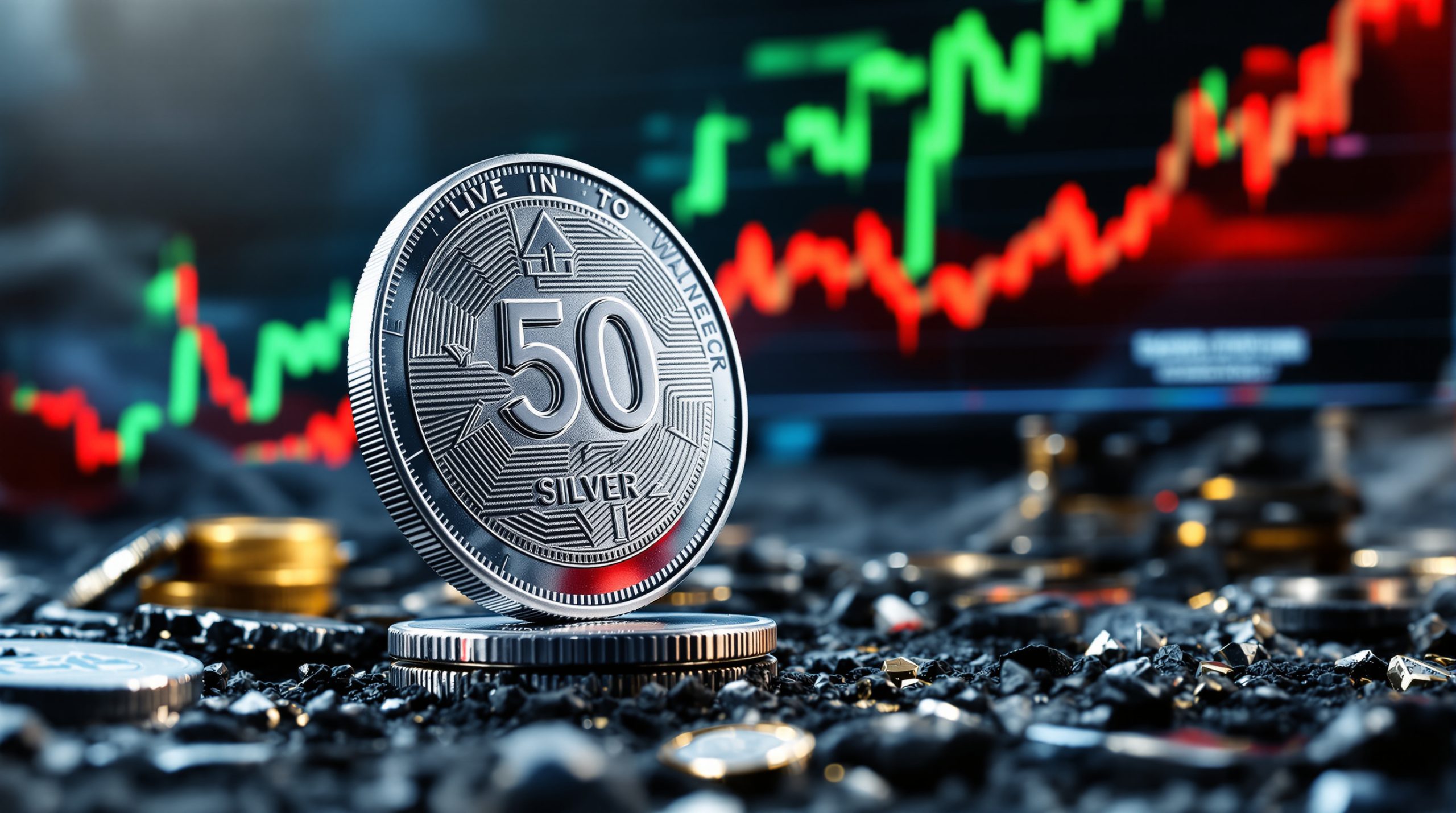What Caused Gold's Historic Breakout in 2023?
Gold's journey to record-breaking heights in 2023 wasn't an overnight phenomenon but rather the culmination of several powerful forces converging at once. After a decade-long consolidation period that tested investor patience, gold finally shattered its resistance levels in spectacular fashion, setting the stage for what many analysts now consider a new secular bull market. The gold breakout 2023 marked a pivotal moment for precious metals investors worldwide.
The Anatomy of a Long-Term Consolidation
Gold's path to its 2023 breakout began with the challenging consolidation phase that started after its previous peak in 2011. For nearly twelve years, gold prices fluctuated within a defined range, repeatedly testing but failing to sustainably break through the crucial $2,000 per ounce psychological barrier.
This extended consolidation created a powerful coiled-spring effect in the gold market. Each time prices approached the $2,000 level—particularly during the COVID-19 market turbulence in 2020—market participants watched closely for signs of a sustained breakout. The technical pattern that emerged resembled a massive cup-and-handle formation, historically associated with significant upside potential once resistance is breached.
When gold finally cleared the $2,100 level decisively in December 2023, it wasn't just breaking a price point—it was overcoming years of accumulated technical resistance with substantial trading volume confirming the move's validity. This breakthrough occurred on significantly higher-than-average trading volume, providing the technical confirmation many analysts had been waiting for.
Macroeconomic Catalysts Behind the Surge
Behind gold's impressive technical breakout stood several powerful macroeconomic drivers. Despite aggressive central bank policies aimed at taming inflation throughout 2023, persistent price pressures continued to undermine confidence in fiat currencies. The Consumer Price Index (CPI) readings, while declining from peak levels, remained stubbornly above central bank targets.
Geopolitical tensions further amplified gold's appeal as a safe-haven asset. Regional conflicts, international trade disputes, and concerns about gold & stock relationship drove investors toward hard assets with proven historical resilience during periods of uncertainty.
Perhaps most significantly, the market began anticipating a pivotal shift in Federal Reserve policy. After an aggressive rate hiking cycle that took interest rates to multi-year highs, economic data in late 2023 suggested the Fed might soon pivot toward a more accommodative stance. This potential policy shift created the perfect environment for gold appreciation, as the metal historically performs best when real interest rates (nominal rates minus inflation) decline or turn negative.
Central Bank Buying: The Institutional Floor
Central bank gold purchases provided unprecedented structural support to gold prices throughout 2023. According to the World Gold Council, central banks collectively acquired 1,037 tonnes of gold in 2023, representing the second-highest annual total on record.
This massive institutional buying created a persistent demand floor under the gold market. Unlike previous gold bull markets, which relied heavily on retail and speculative demand, the 2023 breakout was supported by significant sovereign purchases from countries seeking to diversify reserves away from traditional currencies.
Emerging market central banks led this purchasing trend, with nations across Asia, the Middle East, and Eastern Europe systematically increasing their gold reserves. This shift represented more than temporary tactical positioning—it reflected a strategic reassessment of gold's role in the international monetary system amid growing concerns about currency debasement and financial system stability.
The scale of this central bank buying becomes more impressive when compared to annual gold production. With global mine output reaching approximately 3,644 tonnes in 2023, central banks effectively absorbed more than a quarter of newly mined gold, creating significant pressure on available supply.
How High Can Gold Prices Go After the Breakout?
With gold achieving new all-time highs and breaking through long-standing resistance levels, investors naturally wonder about the metal's upside potential. While predicting exact price targets involves considerable uncertainty, historical patterns and fundamental analysis provide valuable context for estimating gold's potential trajectory.
Technical Price Projections and Targets
Technical analysts utilize several methodologies to project potential price targets following major breakouts. The measured move approach, which extrapolates the height of the consolidation range to estimate upside potential, suggests substantial room for appreciation beyond current levels.
Gold's decade-long consolidation between roughly $1,050 and $2,070 created a range of approximately $1,020. When applied as a measured move from the breakout point, this projects a potential target above $3,000 per ounce—a level that the historic 3000 price surge analysis has already approached in 2024.
Multiple technical resistance levels exist on gold's path higher. The $2,500 level represented significant psychological resistance, while the $3,000 mark currently serves as a major milestone. Beyond these round-number levels, gold faces less defined resistance, as price discovery continues in uncharted territory.
From a time-based perspective, major gold bull markets historically unfold over multi-year periods. The 1970s bull market lasted nearly a decade, while the 2001-2011 advance spanned approximately ten years. If the current bull market follows similar patterns, gold's uptrend could potentially continue through the latter half of this decade.
Expert Forecasts and Market Consensus
Professional analysts from major financial institutions have steadily revised their gold price forecast 2025 upward as the breakout has unfolded. While specific price targets vary considerably, the overall trend has been toward more bullish outlooks.
Forecasts have become increasingly divergent, with conservative estimates suggesting potential consolidation near current levels, while more bullish projections see gold potentially reaching $3,500-$4,000 over the next few years. This wide range reflects genuine uncertainty about how macroeconomic conditions will evolve.
Several factors could accelerate gold's advance, including persistently high inflation, geopolitical escalation, or a more aggressive pivot toward monetary easing by major central banks. Conversely, rapidly rising real interest rates, significant dollar strength, or unexpected economic resilience could limit gold's upside potential.
The accuracy of previous gold market forecasts serves as a cautionary tale. During previous bull markets, most analysts consistently underestimated gold's ultimate peak prices, suggesting that current projections may similarly prove conservative if historical patterns repeat.
The Psychological Impact of New All-Time Highs
The psychological impact of gold reaching new all-time highs extends beyond mere price action. Media coverage intensifies dramatically when gold achieves record prices, bringing attention from investors who previously showed little interest in the precious metals market.
This increased visibility often triggers a self-reinforcing cycle. As more investors learn about gold all-time highs analysis, additional capital flows into the market, potentially accelerating price gains. This pattern has repeated in previous bull markets, where the steepest price advances often occurred after major resistance levels were broken.
Institutional positioning also shifts significantly following confirmed breakouts. Many institutional investors operate under mandate constraints that limit their ability to establish positions in assets lacking clear upward momentum. Once gold demonstrates sustained strength, these constraints relax, potentially unleashing substantial new investment flows.
Previous precious metals bull markets have shown that the most dramatic price advances often occur in the final phase, as broad public participation drives prices significantly above fundamental valuations. While gold's current advance appears fundamentally supported, history suggests the possibility of an eventual euphoric phase that could carry prices well beyond current projections.
Is Gold Overvalued at Current Price Levels?
Despite reaching record nominal prices, the question of gold's valuation remains complex and multifaceted. Multiple analytical frameworks provide different perspectives on whether gold has become overvalued or still offers reasonable value at current levels.
Measuring Gold's Value in Historical Context
When adjusted for inflation, gold's current price remains below its 1980 peak in real terms. Using the Consumer Price Index to adjust historical prices, gold would need to exceed $3,500 per ounce to match its January 1980 high in today's dollars. This suggests that despite nominal record prices, gold hasn't yet reached extreme valuation levels from a long-term historical perspective.
The gold-to-S&P 500 ratio provides another valuable context. This ratio measures gold's price relative to equities, helping identify relative valuation extremes. During periods when gold appears undervalued compared to stocks, the ratio reaches low levels, as it did in the late 1990s before gold's 2001-2011 bull market. Conversely, when gold becomes potentially overvalued relative to equities, the ratio reaches high levels, as occurred in 1980.
Similar insights come from examining gold's relationship to other assets, including oil, housing, and industrial commodities. These comparisons help contextualize gold's price movements within broader market dynamics.
Gold's purchasing power across different time periods reveals its effectiveness as a long-term store of value. While gold experiences significant price volatility in shorter timeframes, its purchasing power has remained remarkably stable across decades and even centuries—a characteristic few other assets can claim.
Fundamental Valuation Frameworks
Traditional valuation metrics like price-to-earnings ratios don't apply directly to gold, but several fundamental factors influence its intrinsic value. Global gold production faces increasing constraints as mining companies struggle with declining ore grades and rising extraction costs.
The all-in sustaining costs (AISC) for gold production averaged approximately $1,200-$1,400 per ounce in 2023, according to major mining company reports. This cost floor provides fundamental support for gold prices, as sustained periods below production costs would eventually reduce supply by forcing mine closures.
The industry's reserve replacement challenges further support gold's fundamental outlook. Major gold discoveries have become increasingly rare despite rising exploration budgets. Many mining executives acknowledge that the era of easily discovered high-grade deposits has largely ended, requiring companies to develop lower-grade, more complex projects with higher capital requirements.
Production-to-reserves ratios among major gold miners have declined over the past decade, indicating that companies are depleting their existing resource base faster than they're replacing it through new discoveries. This trend suggests potential long-term supply constraints that could support higher gold prices.
Comparing Gold to Alternative Investments
Gold's performance relative to traditional equity markets varies significantly across different time periods. While equities generally outperform gold during periods of economic expansion and monetary stability, gold often delivers superior returns during periods of financial stress, high inflation, or geopolitical uncertainty.
Among precious metals, gold typically exhibits lower volatility than silver or platinum. Silver's dual role as both a precious and industrial metal creates more complex price dynamics, while platinum's smaller market size contributes to greater price volatility. These characteristics make gold the preferred precious metal for conservative investors seeking portfolio stability.
The relationship between gold and cryptocurrencies continues to evolve. While both asset classes appeal to investors concerned about currency debasement, they demonstrate fundamentally different risk profiles. Gold's millennia-long history as a store of value contrasts sharply with cryptocurrencies' relatively brief existence, resulting in substantially different volatility patterns and regulatory considerations.
When compared to inflation-protected securities like TIPS (Treasury Inflation-Protected Securities), gold has historically provided superior protection during periods of unexpected inflation or financial system stress. Unlike TIPS, gold carries no counterparty risk and maintains value even during extreme financial disruptions.
Who Benefits Most From Gold's Breakout?
Gold's price appreciation creates winners across multiple segments of the market, from mining companies to investment vehicles and even regional economies. However, the magnitude of benefits varies significantly based on operational leverage, cost structures, and exposure mechanisms.
Mining Company Profitability Analysis
Gold mining companies experience disproportionate profit increases when gold prices rise due to operational leverage. With fixed costs representing a large portion of their expense structure, miners typically see margins expand by 2-3 times the percentage increase in gold prices.
For example, a mining company with an all-in sustaining cost of $1,300 per ounce would generate a $700 margin at a $2,000 gold price. If gold rises 20% to $2,400, the company's margin expands to $1,100—a 57% increase. This leverage effect makes mining stocks potentially more responsive to gold market surge than the metal itself.
Tier analysis reveals significant variation among producers. Low-cost operators with all-in sustaining costs below $1,000 per ounce benefit most dramatically from rising prices, while higher-cost producers with expenses above $1,500 experience more modest margin expansion.
Higher gold prices also stimulate increased exploration activity. Mining companies typically allocate larger portions of their cash flow to exploration during bull markets, potentially leading to new discoveries that enhance long-term production prospects.
The improved financial condition of mining companies during gold bull markets often triggers increased merger and acquisition activity. Larger producers with strong balance sheets acquire smaller companies with promising deposits, accelerating industry consolidation.
Investment Vehicle Performance Comparison
Investors can gain exposure to gold's price movements through multiple vehicles, each offering different risk-reward characteristics. Physical gold provides direct price exposure without counterparty risk, making it the most conservative option for long-term holders concerned about financial system stability.
Gold ETFs offer convenient exposure with minimal storage concerns, though they involve ongoing management fees and potential counterparty risks. During gold's 2023 breakout, major gold ETFs experienced significant inflows as investors sought simplified access to the metal's price appreciation.
Mining stocks typically demonstrate greater volatility than physical gold due to operational leverage. During gold's breakout phase, many major mining stocks outperformed the metal itself, though this relationship doesn't always hold during market disruptions when equities face broader selling pressure.
Junior exploration companies often experience the most dramatic percentage gains during gold bull markets. These early-stage companies, focused on discovering new deposits rather than producing gold, can see share prices multiply when successful exploration results coincide with rising gold prices.
Royalty and streaming companies occupy a middle ground in the risk spectrum. These businesses provide upfront capital to miners in exchange for the right to purchase future production at predetermined prices. This model provides exposure to gold's upside with reduced operational risks compared to traditional miners.
Regional Economic Impacts
Major gold-producing nations experience significant economic benefits during gold bull markets. Countries like Australia, Canada, Russia, and South Africa derive substantial export earnings from gold production, positively affecting their trade balances and currency values.
Employment impacts extend beyond direct mining jobs. Each primary mining position typically supports multiple additional jobs in supporting industries, from equipment manufacturing to transportation and services. This multiplier effect amplifies gold mining's economic contribution in producing regions.
Tax revenue increases substantially during gold bull markets. Mining companies generate higher taxable profits, while increased employment creates additional income tax revenue. Many jurisdictions also impose specific mining royalties or resource taxes that provide direct government revenue tied to production values.
Local communities near major mining operations often benefit from increased corporate social investment during profitable periods. Mining companies typically expand their community development initiatives when cash flows improve, potentially enhancing local infrastructure, education, and healthcare resources.
What Are the Risks to Gold's Continued Uptrend?
Despite gold's impressive performance, several potential risks could disrupt its upward trajectory. Prudent investors recognize these challenges while maintaining appropriate exposure based on their risk tolerance and investment objectives.
Technical Warning Signs to Monitor
As gold reaches new price levels, several technical indicators merit close attention. Overbought readings on momentum oscillators like the Relative Strength Index (RSI) often precede short-term corrections, though these signals can remain elevated for extended periods during strong bull markets.
Volume patterns during price advances provide important confirmation signals. Healthy uptrends typically feature rising prices accompanied by increasing volume, while declining volume during price advances may signal diminishing momentum.
Divergences between price action and momentum indicators can provide early warning signs of trend exhaustion. When gold makes new price highs while momentum indicators fail to confirm with corresponding new highs, the likelihood of a correction increases.
Historical analysis suggests that even during strong bull markets, gold typically experiences multiple corrections of 10-15%. More significant retracements of 20-30% have occurred during previous gold bull markets without invalidating the underlying uptrend. Investors should anticipate similar volatility patterns in the current cycle.
Macroeconomic Headwinds
Rising real interest rates represent perhaps the most significant potential headwind for gold prices. When inflation-adjusted yields on government bonds increase, the opportunity cost of holding non-yielding assets like gold rises correspondingly. The relationship between real rates and gold prices has historically shown strong negative correlation.
Dollar strength scenarios could create additional pressure. As gold is primarily priced in U.S. dollars, a strengthening dollar makes gold more expensive for holders of other currencies, potentially reducing demand. Gold has historically struggled during periods of exceptional dollar strength.
Inflation normalization below central bank targets would challenge one of gold's primary bullish narratives. If inflation returns to the 2% level targeted by major central banks without requiring prolonged easy monetary policy, investor demand for inflation hedges may diminish.
Economic recovery that exceeds expectations could redirect capital from safe-haven assets toward growth-oriented investments. During periods of robust economic expansion and rising corporate profits, investors typically reduce defensive allocations in favor of assets offering higher expected returns.
The gold breakout 2023 represented a significant turning point in the precious metals market, marking the beginning of what many analysts consider to be a new secular bull market with substantial upside potential in the coming years.
Ready to Catch the Next Major Gold Market Move?
Discover significant gold market opportunities before they happen with Discovery Alert's proprietary Discovery IQ model, providing real-time alerts on ASX-listed gold stocks with promising discoveries. Explore our dedicated discoveries page to see the historic returns of major mineral discoveries and how you can position yourself ahead of the market.




